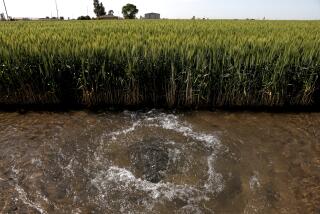Bush Plan Would Give States Leeway on Clean Water
WASHINGTON — In what environmentalists say is a significant rollback of the Clean Water Act, the Bush administration has decided to amend a critical water pollution program to give states much greater leeway in deciding which waterways need to be cleaned and crafting plans to do so.
Under this proposal, the federal government would not have power of approval over state plans for cleaning waterways, but instead would “trust the states,” according to an EPA outline.
Environmentalists warned that the proposal, which is still being drafted, would undermine the landmark 1972 legislation, which has as its primary goal to make all waterways suitable for fishing and swimming.
But EPA officials countered that they are responding to the advice of a National Academy of Sciences’ panel, which called for a more science-based approach to the federally mandated program that requires states to clean up lakes, rivers and other bodies of water.
The goal is to give states “more cost-effective and better ways to manage the program,” said Benjamin H. Grumbles, deputy assistant EPA administrator for water.
The proposal, which would not require congressional approval to implement, reflects the Bush administration’s emphasis on giving states more authority over a broad range of government programs, a trend that environmentalists resist because most states traditionally have been less aggressive than the federal government in forcing industries to clean up pollution they created.
The program in question, Total Maximum Daily Load, includes about 21,000 waterways, or about 40% of the nation’s total. They are classified as polluted despite the installation of pollution controls at factories, wastewater treatment plants and other facilities with discharge pipes. Agricultural runoff and urban storm water are major sources of the pollution in these waterways.
EPA officials would not reveal the details of their plan to amend the Total Maximum Daily Load program, but a document provided to congressional staffers outlining the proposal shed light on the agency’s thinking.
Under the current program, states are required to list each polluted lake, river or other body of water. Waterways are considered “impaired” if there are any credible data that they are polluted. Once a lake or river is on the list, states are required to determine how much pollution it can take and still meet water-quality standards--its total maximum daily load--and then allocate how much pollution can come from each source.
The proposal would raise the bar on how much information is needed to put a waterway on the list. This would allow states to determine that they do not have enough data on a particular lake or river, thus removing it from their list of impaired waterways. By doing so, they could avoid, or at least delay, the complicated and costly process of determining how much pollution can be allowed and from which sources.
The proposal would also make it easier for states to reclassify the uses of the waterway, thus possibly permitting higher levels of pollutants.
The National Academy of Sciences’ panel noted that because many of the waterways were put on the lists without adequate water-quality data, they may not actually violate water-quality standards.
But environmentalists warned that the changes would create huge loopholes that would allow states to avoid the difficult task of cleaning up these lakes and rivers.
“If finalized, the impact of this proposal will be that your children and your grandchildren will have to get used to living with dirty water,” said Joan Mulhern, senior legislative counsel for Earthjustice, a national environmental law group. “There is no other program under the Clean Water Act that will get the water clean.”
Daniel Rosenberg, an attorney for the Natural Resources Defense Council, said the fact that the states have done so little to implement the program to date shows that they should not be given even more leeway.
Although total maximum daily loads have been required by the Clean Water Act since its implementation, very few were developed. In recent years, citizens’ groups began suing the EPA to seek these designations. To date, there have been about 40 legal actions in 38 states, and the EPA is under court order or consent decree in many states to ensure that total maximum daily loads are established, either by the state or by the agency.
California has made more headway than most states in implementing the program, in hopes of cleaning its 1,400 dirty waterways.
“Trusting the states is a completely bankrupt approach to implementing the program; that’s what’s failed for the last 30 years,” Rosenberg said. “If EPA seriously thinks the waters of the U.S. are going to be made clean by cutting out citizen enforcement and trusting the states, they might as well call for revoking the Clean Water Act entirely.”
“The real agenda is to get as many of the waters off the list so they don’t have to do” total maximum daily loads, he added.
But Grumbles said the EPA would continue to oversee whether states determine how much pollution a waterway can take, as required by law.
“We’re not backing away from a strong federal EPA role,” Grumbles said.
But the EPA would not oversee the states’ plans for cleaning up the waterways, as was the plan under the Clinton administration’s rules. Those rules were put on hold first by Congress and then by the Bush administration.
The EPA proposal is supported by the state sewer treatment agencies and state water pollution control administrators, which complain that current rules are unworkable and antiquated.
More to Read
Sign up for Essential California
The most important California stories and recommendations in your inbox every morning.
You may occasionally receive promotional content from the Los Angeles Times.










